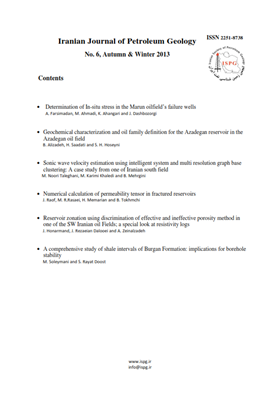-
-
List of Articles
-
Open Access Article
1 - Determination of In-situ stress in the Marun oilfield’s failure wells
میثم فارسی مدان مرتضی احمدی کاوه آهنگری جاسم دشت بزرگی -
Open Access Article
2 - Geochemical characterization and oil family definition for the Azadegan reservoir in the Azadegan oil field
سید حسین حسینی -
Open Access Article
3 - Sonic wave velocity estimation using intelligent system and multi resolution graph base clustering: A case study from one of Iranian south field
مرتضی نوری مینا کریمی خالدی -
Open Access Article
4 - FXGHFGH
بلابلا بلالا -
Open Access Article
5 - Sonic wave velocity estimation using intelligent system and multi resolution graph base clustering: A case study from one of Iranian south field
-
Open Access Article
6 - Numerical calculation of permeability tensor in fractured reservoirs
سیما جلیلی رئوف حسین معماریان محمد رضا رسائی بهزاد تخم چی -
Open Access Article
7 - زونبندي مخزن با استفاده از روش تفکيک تخلخل مفيد و غيرمفيد در يكي از ميادين نفتي جنوب غرب ايران؛ با نگرش ويژه به نمودارهای مقاومت
-
Open Access Article
8 - Reservoir zonation using discrimination of effective and ineffective porosity method in one of the SW Iranian oil Fields; a special look at resistivity logs
-
Open Access Article
9 - Reservoir zonation using discrimination of effective and ineffective porosity method in one of the SW Iranian oil Fields; a special look at resistivity logs
جواد هنرمند ژیلا رضائیان دلوئی ارسلان زینل زاده -
Open Access Article
10 - A comprehensive study of shale intervals of Burgan Formation: implications for borehole stability
Mohammad سلیمانی سعیده رعیت دوست
-
The rights to this website are owned by the Raimag Press Management System.
Copyright © 2017-2025







